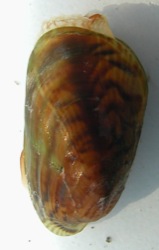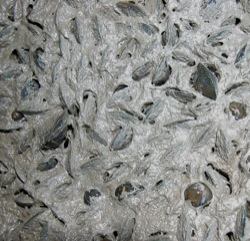Musculista senhousia (Benson in Cantor, 1842)
GREEN BAGMUSSEL, GREEN MUSSEL, SENHOUSE'S MUSSEL, JAPANESE MUSSEL, ASIAN DATE MUSSEL
- Kingdom: Animalia
- Phylum: Mollusca
- Class: Bivalvia
- Subclass: Pteriomorpha
- Order: Mytiloida
- Family: Mytilidae
Musculista senhousia is a small olive-green, yellow-green or greenish-brown mussel, which grows to a maximum length of 35 mm. There are pale purple stripes radiating from the center of growth out to the hind margin of the shell, mainly on the upper hind diagonal half of the shell; and often there are dark purple-brown, wavy or zigzag, concentric lines or arcs surrounding the center of growth. The shell is smooth and shiny, and the interior is a lustrous purplish-gray, with the stripes often showing through the thin shell. The umbo—the hump at the center of growth—is near but not right at the edge of the head end of the shell. The lower edge of the shell, opposite the hinge, is often slightly concave.
Musculista senhousia lives on both hard and soft substrates in the intertidal and shallow subtidal zones to 20 m depth. It is reported to be tolerant of low salinity and low oxygen levels. In San Francisco Bay it has been collected at salinities of 17-33 parts per thousand and temperatures of 17-24° C, and in southern California at 35-37 parts per thousand and 25-27° C.
Musculista senhousia matures in about 9 months and can live for 2 year. It is a broadcast spawner, with fertilization occurring in the water column. The larvae drift in the plankton for 14-55 days. While they can settle on hard surfaces like most mussels, they prefer to settle gregariously on soft substrates. They burrow down into the sediment leaving only the hind part of their shell protruding, and then secrete fibrous threads that attach to sediment particles to form a kind of nest or bag around them.
When Musculista senhousia settles in dense patches, the threads from neighboring nests entangle to form a mat over the sediment surface. It has been reported in such mats at densities of up to 2,500 mussels per square meter in Hong Kong, 2,600 per square meter in Western Australia, 2,800 per square meter in Japan, 3,300 per square meter in New Zealand, 8,600 per square meter in Mission Bay, 12,400 per square meter in San Diego Bay and 16,000 per square meter at Auckland, New Zealand. Crooks (2002) reported that densities of 5,000-10,000 per square meter are typical in mats in Mission Bay, with peak densities of over 150,000 mussels per square meter. Juveniles have been reported to settle on eelgrass at densities of 28,650 per square meter and on synthetic line at 126,000 per square meter; they later drop off these substrates to settle in mats on the bottom.
Crooks (1998, 2001) reported that the complex surface structure provided by Musculista senhousia mats increased the abundance of amphipods, tanaids, small snails and polychaete worms, but that the abundance of native, filter-feeding cockles declined, possibly because of competition for food. Musculista senhousia has also been blamed for smothering and killing bivalves, including cultivated clams, in China and Japan. In southern California, modest densities of Musculista senhousia were reported to enhance growth of the eelgrass Zostera marina through deposition of nutrients, while higher densities inhibited its spread; in return, dense eelgrass stands inhibited Musculista senhousia's growth by reducing water flows and the delivery of phytoplankton (Reusch & Williams 1998; Allen & Williams 2003). Snails, crabs, lobsters, starfish, fish and shorebirds and diving ducks are all reported to feed on Musculista senhousia (Crooks 2002).
Musculista senhousia has been used as fish bait and feed stock for shrimp and crab culture in Japan, and for food in China, with attempts made at culturing them.
Native Range
Asia from Siberia, the Kurile Islands, Japan, and Korea along the China coast to Singapore.
Introduction and Distribution on the Pacific Coast
[with dates of first record]
- British Columbia: Savary Island in the Strait of Georgia
- Washington: Puget Sound [collected in 1924]
- California: Humboldt Bay [collected in 2001], Bodega Harbor [collected in 1971], Tomales Bay [collected in 1941], San Francisco Bay [collected in 1946], Port Hueneme [collected in 2000-2001], Los Angeles/Long Beach harbors [collected in 2001], Rainbow Lagoon near Long Beach Harbor [collected in 2000], Huntington Harbor [collected in 2001], Newport Bay [reported in 1977], Oceanside Harbor [collected in 2001], Mission Bay [collected in 1965], San Diego Bay [collected in 1976]
- Baja California: Papilote Bay near Ensenada [collected in 1970], Estero de Punta Banda [reported in 1994]
Musculista senhousia was reported in Bolinas Lagoon in 1944, and collected in Elkhorn Slough in 1965 but there are no recent records and it no longer appears to be present in either site. In the 1990s it was planted in Willapa Bay in shipments of Manila clams (Venerupis philippinarum), but did not become established.
In Puget Sound, Musculista senhousia was collected on beds of planted Japanese oysters (Crassostrea gigas) in Samish Bay, in the northern part of the Sound, in 1924, but probably did not become established at that time. It was next recorded from Puget Sound in 1959, at Olympia at the southern end of the Sound, and later at other sites in the South Sound.
Musculista senhousia is very common and widely distributed in San Francisco Bay, ranging from Grizzly and Suisun bays and the mouths of the Napa and Petaluma rivers in the north to the southernmost reaches of the bay, and to near to the mouth of the bay. In Lake Merritt (a shallow, brackish lagoon on the eastern shore of the bay) and in the Oakland Estuary, Musculista senhousia has occurred in mats that can be pulled from the bottom in sheets, and as individuals among the fouling on pilings and floats. At Crown Beach in Alameda it is found in individual nests attached to the base of eelgrass plants (Zostera marina) It has been collected at densities of up to 1,000-2,000 clams per square meter from the South Bay to San Pablo Bay, where it is frequently one of the most abundant benthic organisms.
As noted, the first Pacific Coast record of Musculista senhousia was on planted oyster beds in Puget Sound in 1924, and the first record of an apparently established population was at Tomales Bay in 1941. In both cases it was probably introduced with plantings of Japanese oysters, since it has been collected on arriving oyster shipments in both Washington and California. These plantings began in Samish Bay in 1905, in Tomales Bay and Elkhorn Slough in the 1920s, in Bodega Harbor and San Francisco Bay in the 1930s, in Humboldt Bay in the 1950s, and in Estero de Punta Banda by the 1970s, all before Musculista senhousia was collected at these sites. Other possible mechanisms include transport in ballast water (at 14-55 days, Musculista senhousia's larval planktonic stage is long enough for ballast water transport, either between Pacific Coast ports or across the Pacific Ocean from Asia), or as hull fouling on ships or boats. Carlton (1979) suggested that Musculista senhousia's arrival in southern California in the 1960s and 1970s may be related to the increase in ship movements between California and the western Pacific during the Vietnam War.
Additional Global Distribution [with dates of first record]
Australia in Western Australia [collected in 1983], Victoria [collected in 1987] and Tasmania [1995]; New Zealand [1978]; Mediterranean France [early 1980s in the Thau Lagoon], Italy [1980s in the Ravenna Lagoon and Adriatic Sea], Slovenia [reported in 1997], Egypt [reported in 1971], Israel [1964]
Musculista senhousia is thought to have been introduced into Australia and New Zealand in ship fouling, in ships' seawater systems or in ballast water. It was collected from the internal seawater systems of vessels in South Australia in 1988 and northern Australia in 1999. Shellfish may have played a role in its introduction and spread in the Mediterranean, including oysters imported from Japan for culturing in the Thau Lagoon in France around 1978, and the Manila clam imported for culturing in the Adriatic in 1986.
Other names that have been used in the scientific literature
Musculus senhousia, Modiola senhousia, Modiolus demissus (misidentification by Filice (1959) in San Francisco Bay)
Literature Sources and Additional Information
Allen, B. J. and S.L. Williams. 2003. Native eelgrass Zostera marina controls growth and reproduction of an invasive mussel through food limitation. Marine Ecology Progress Series 254: 57-67.
Carlton, J.T. 1979. History, Biogeography, and Ecology of the Introduced Marine and Estuarine Invertebrates of the Pacific Coast of North America. Ph.D. thesis, University of California, Davis, CA (pp. 449-453).
Coan, E.V., P. Valentich-Scott, F.R. Bernard and P.S. Sadeghian. 2000. Bivalve Seashells of Western North America. Santa Barbara Museum of Natural History Monographs, Santa Barbara, CA.
Cohen, A.N. and J.T. Carlton. 1995. Nonindigenous Aquatic Species in a United States Estuary: A Case Study of the Biological Invasions of the San Francisco Bay and Delta. U.S. Fish and Wildlife Service, Washington, DC (p. 64-65).
Crooks, J.A. 1998. Habitat alteration and community-level effects of an exotic mussel, Musculista senhousia. Marine Ecology Progress Series 162: 137-152.
Crooks, J.A. 2001. Assessing invader roles within changing ecosystems: historical and experimental perspectives on an exotic mussel in an urbanized lagoon. Biological Invasions 3: 23-36.
Crooks, J.A. 2002. Predators of the invasive mussel Musculista senhousia (Mollusca: Mytilidae). Pacific Science 56(1): 49-56.
Morton, B. 1974. Some aspects of the biology, population dynamics and functional morphology of Musculista senhousia Benson (Bivalvia, Mytilidae). Pacific Science 28: 19-33.
Reusch, T.B.H. and S.L. Williams. 1998. Variable responses of a native eelgrass Zostera marina to a non-indigenous bivalve Musculista senhousia. Oecologia 113: 428-441.
Willan, R.C. 1987. The mussel Musculista senhousia in Australasia: another aggressive alien highlights the need for quarantine at ports. Bulletin of Marine Science 41(2): 475-489.
Websites
CIESM - Atlas of Exotic Species in the Mediterranean
http://www.ciesm.org/atlas/Musculistasenhousia.html
CSIRO Centre for Research on Introduced Marine Pests (CRIMP) - Marine
Pest Information Sheets
http://www.marine.csiro.au/crimp//Marine_pest_infosheets.html
CSIRO Centre for Research on Introduced Marine Pests (CRIMP) - National
Introduced Marine Pest Information System (NIMPIS)
http://www.marine.csiro.au/crimp/nimpis
Government of Western Australia/Department of Fisheries - Introduced Marine
Aquatic Invaders
http://www.fish.wa.gov.au/hab/broc/marineinvader/marine06.html

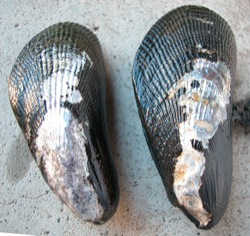 Geukensia demissa
Geukensia demissa Musculista senhousia
Musculista senhousia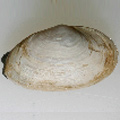 Mya arenaria
Mya arenaria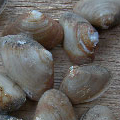 Corbula amurensis
Corbula amurensis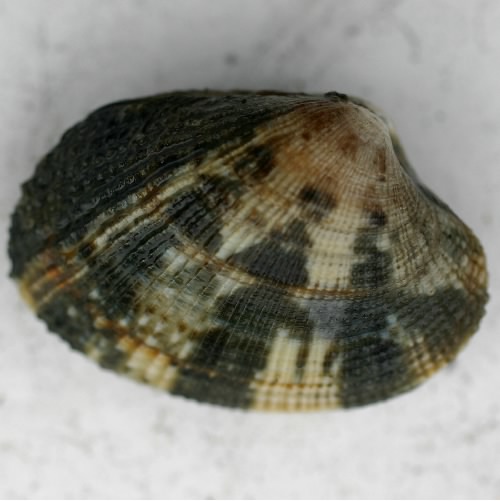 Venerupis philippinarum
Venerupis philippinarum